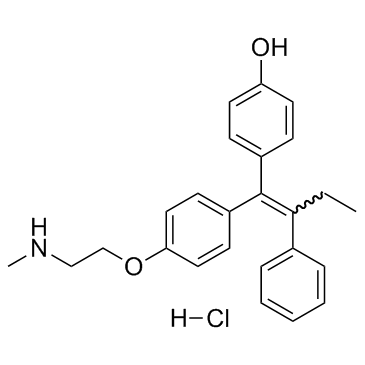1197194-41-4
| Name | 308PA1L567 |
|---|---|
| Synonyms |
4-[(1Z)-1-{4-[2-(Methylamino)ethoxy]phenyl}-2-phenyl-1-buten-1-yl]phenol hydrochloride (1:1)
308PA1L567 Phenol, 4-[(1Z)-1-[4-[2-(methylamino)ethoxy]phenyl]-2-phenyl-1-buten-1-yl]-, hydrochloride (1:1) ENDOXIFEN HYDROCHLORIDE Endoxifen (hydrochloride) |
| Description | Endoxifen hydrochloride, the active metabolite of Tamoxifen, is a potent antiestrogen that targets estrogen receptor. |
|---|---|
| Related Catalog | |
| Target |
Estrogen receptor[1] |
| In Vitro | Endoxifen blocks ER-alpha transcriptional activity and inhibits estrogen-induced breast cancer cell proliferation. These studies reveal that Endoxifen concentrations between 10 and 1000 nM enhance ERα protein degradation. Lower concentrations of Endoxifen (≤1 nM) do not affect ERα protein levels[1]. |
| In Vivo | GLAST::Cre(ERT);ROSA26loxP/loxP mice are injected intraventricularly with 5 μL 5 mM Endoxifen, and mice injected with 4 μL Adeno-Cre virus [109 plaque-forming units (pfu)] serve as positive control. At 7-10 days after ICV injection, mice are sacrificed and the SVZ dissected to isolate and derive stem and progenitor cells. These stem/progenitor cells are then cultured in permissive medium to form neurospheres and assayed for recombination. In our unpassaged preparations is found derived from Endoxifen-injected GLAST::CreERT2;ROSA26loxP/loxP mice that 1.9% of neurospheres show recombination, compared to a higher rate of 4.3% of neurospheres in Adeno-Cre-recombined ROSA26loxP/loxP mice[2]. |
| Cell Assay | MCF7 and Ishikawa cells are grown in 10% triple charcoal-stripped serum-containing medium for 3 d. The cells are then plated at a density of 2,000 cells per well in 96-well tissue culture plates and treated as indicated every 48 h. Cell proliferation assays are conducted 8 days after the first treatment using a CellTiter-Glo Luminescent Cell Viability kit[1]. |
| Animal Admin | Mice[2] GLAST::CreERT2 mice are used. Tamoxifen is injected as active metabolite 4-hydroxytamoxifen (4-OH-TAM), or 4-hydroxy-N-desmethyltamoxifen (Endoxifen). 4-OH-TAM is dissolved at 1 mM concentration in 2% ethanol/PBS and 5 μL injected into the ventricles. Endoxifen has not been used before for the induction of the ERT2 system. Endoxifen hydrochloride hydrate has a recommended solubility of over 10 mg/mL (25 mM) in 100% DMSO, corresponding to a maximum concentration of 25 mM or a dose of 125 nmol in a 5 μL volume. At this concentration, a proportion of mice developed neurological signs suggestive of neurotoxicity. Subsequently, concentrations of 2.5, 5, 10, 12.5 and 25 mM, dissolved in 10, 20, 40, 50 and 100% DMSO, respectively, corresponding to a drug dose of 12.5, 25, 50, 62.5 and 125 nmol are used. For testing DMSO toxicity, groups of three mice are injected with 5 uL PBS, 50% DMSO in PBS or 100% DMSO in PBS. Mice are culled 9 days after injection and coronally sectioned brains are stained for cleaved caspase 3, GFAP and Iba1. |
| References |
| Molecular Formula | C25H28ClNO2 |
|---|---|
| Molecular Weight | 409.948 |
| Exact Mass | 409.180847 |
| Storage condition | 2-8℃ |
